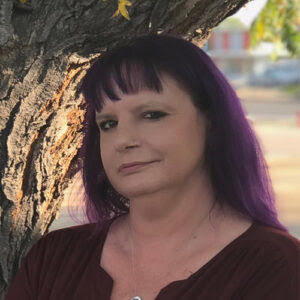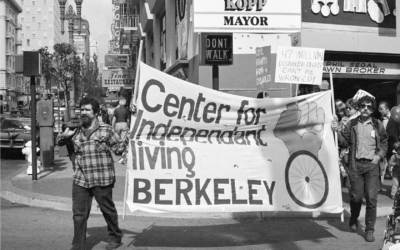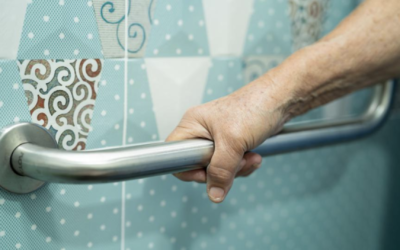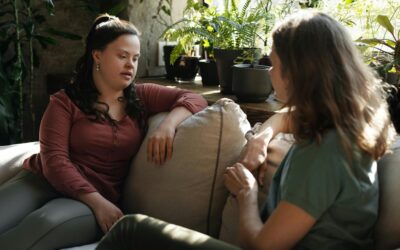With support and assistance, over a period of years, Amber brought her life from being stuck at home with debilitating mental illness, to being fully engaged at a job, socially, and in her family. Her story is one of hope and empowerment, and also one highlighting that not all disabilities are visible and obvious.

Image Description: Amber smiles at the camera. She is pictured from the shoulders up. Her hair is purple and falls straight behind her shoulders. She is wearing a burgundy top. Behind her is a tree trunk.
“I was diagnosed with Bipolar II and PTSD,” she explains. “I was antisocial and wouldn’t leave the house for weeks at a time; I couldn’t even call for pizza; the grocery stores were scary.”
Due to domestic issues, Amber also left her husband when she was just several weeks pregnant and on disability. She was in challenging circumstances for quite some time, surviving, but not living a full and independent life.
“I was in socialized housing, kind of getting by, and a friend of mine suggested I try going to online school – that way I wouldn’t have to go out, and I could care for my son,” she said. She started off at the University of Phoenix and after a time transferred to the University of Northern Colorado, where she found the opportunity to do an internship at Connections for Independent Living in Greeley.
“I didn’t think I could do it because I hadn’t worked in so long,” she shared. “But I showed up, and my supervisor Colin encouraged me and helped me believe that I could; that I could go from a person with a disability on benefits to a person with a job who could support herself and her son.”
Amber started her Ticket to Work (TTW) program with the Division of Vocational Rehabilitation (DVR) in Greeley and was able to get a starting job at the Connections for Independent Living in Greeley. “When I completed with DVR, they provided me with a list of Employment Networks and that’s how I found the Center for People With Disabilities (CPWD),” she remembered. “I had only been working at the Greeley Center a couple of months.”

This is the logo of the Ticket to Work program. Swirling lines encircle three colored spheres. A larger swirling line swoops down below the text Ticket to Work.
Amber connected with Jan Dabroski, Certified Community Partner Work Incentives Counselor (CPWIC) and Employment Coordinator/Benefits Specialist at CPWD, who assisted her in continuing her journey toward full employment and independence.
“CPWD helped me reach my goals by being there to answer my questions and acknowledging the progress I was making,” Amber said. “I had my own little cheerleader. Jan helped me keep track of my progress and provided great assistance in communicating with the Social Security Administration (SSA) about my benefits during my transition to full employment. This support just made me believe in myself even more.”
Amber has now been successfully employed and living independently for close to 5 years. During this time, she has gone from an intern to an Employment Specialist, to a Team Lead. She is completely off Social Security Disability Insurance (SSDI), has moved into a better home, is taking great care of her son who is now 12, bought and paid off her first brand new car, and was nominated for the Personal Achievement Award through the Association of People Supporting Employment First (APSE).
For anyone in a similar situation, looking to get off of benefits, work full-time, and live a full and independent life, Amber has some sound advice:
- “I would say start out slow. I did my first 3 years at the University of Phoenix, and that gave me the confidence I needed to go to college in person. In college, I learned to be responsible and accountable for what I could and could not do, and learned to use the disability resource center and ask for help.”
- “When getting off SSDI, take baby steps. Try things out to find out what you like to do. You can supplement your income while on SSDI without making the jump until you’re ready.”
- “Reach out to DVR and other resources. Get the support and help you need. If you don’t have anyone in your life right now, there are people at the Centers for Independent Living (Cils) and other places that will support you. Colin was that for me – he gave me the courage to try. You can get a case manager at DVR, or an Independent Living Advisor at a CIL, and find a therapist and a doctor to help you, too.”
Amber said that getting started is the hardest part. Pulling out of the hopelessness and challenge and taking the first steps is a huge hurdle, but that doesn’t last forever.
“It’s a change, but once you start to work towards your independence, it feels better and better with each step. Doing the TTW program has helped me immensely. I would recommend it to any person with a disability who wants to work. For me, work has been not only financially rewarding but also given me the confidence to live the life I want.”
Learn more about Ticket to Work and CPWD’s Employment Program HERE.





